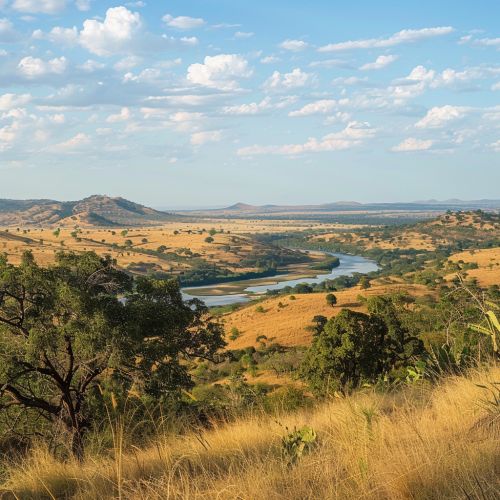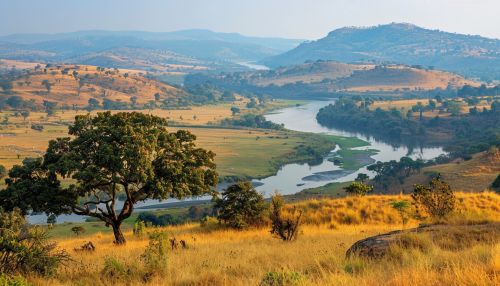Zambia: Difference between revisions
(Created page with "== Geography and Climate == Zambia is a landlocked country located in Southern Africa, bordered by eight countries: Tanzania to the northeast, Malawi to the east, Mozambique to the southeast, Zimbabwe to the south, Botswana and Namibia to the southwest, Angola to the west, and the Democratic Republic of the Congo to the north. The country covers an area of approximately 752,618 square kilometers, making it the 39th largest country in the world. <div class='only_on_desk...") |
No edit summary |
||
| Line 3: | Line 3: | ||
Zambia is a landlocked country located in Southern Africa, bordered by eight countries: Tanzania to the northeast, Malawi to the east, Mozambique to the southeast, Zimbabwe to the south, Botswana and Namibia to the southwest, Angola to the west, and the Democratic Republic of the Congo to the north. The country covers an area of approximately 752,618 square kilometers, making it the 39th largest country in the world. | Zambia is a landlocked country located in Southern Africa, bordered by eight countries: Tanzania to the northeast, Malawi to the east, Mozambique to the southeast, Zimbabwe to the south, Botswana and Namibia to the southwest, Angola to the west, and the Democratic Republic of the Congo to the north. The country covers an area of approximately 752,618 square kilometers, making it the 39th largest country in the world. | ||
[[Image:Detail-91311.jpg|thumb|center|Scenic view of Zambia's landscape with rolling hills, savannas, and a river.|class=only_on_mobile]] | |||
[[Image:Detail-91312.jpg|thumb|center|Scenic view of Zambia's landscape with rolling hills, savannas, and a river.|class=only_on_desktop]] | |||
The terrain of Zambia is predominantly high plateau with some hills and mountains. The country is divided into three major geographical regions: the high plateau, the Zambezi Valley, and the Kalahari Basin. The high plateau, which covers most of the country, is characterized by flat to gently undulating terrain at an elevation of about 1,000 to 1,500 meters above sea level. The Zambezi Valley, located in the southern part of the country, is a low-lying area that follows the course of the Zambezi River. The Kalahari Basin, in the southwestern part of Zambia, is a semi-arid region with sandy soils and sparse vegetation. | The terrain of Zambia is predominantly high plateau with some hills and mountains. The country is divided into three major geographical regions: the high plateau, the Zambezi Valley, and the Kalahari Basin. The high plateau, which covers most of the country, is characterized by flat to gently undulating terrain at an elevation of about 1,000 to 1,500 meters above sea level. The Zambezi Valley, located in the southern part of the country, is a low-lying area that follows the course of the Zambezi River. The Kalahari Basin, in the southwestern part of Zambia, is a semi-arid region with sandy soils and sparse vegetation. | ||
Latest revision as of 20:41, 21 June 2024
Geography and Climate
Zambia is a landlocked country located in Southern Africa, bordered by eight countries: Tanzania to the northeast, Malawi to the east, Mozambique to the southeast, Zimbabwe to the south, Botswana and Namibia to the southwest, Angola to the west, and the Democratic Republic of the Congo to the north. The country covers an area of approximately 752,618 square kilometers, making it the 39th largest country in the world.


The terrain of Zambia is predominantly high plateau with some hills and mountains. The country is divided into three major geographical regions: the high plateau, the Zambezi Valley, and the Kalahari Basin. The high plateau, which covers most of the country, is characterized by flat to gently undulating terrain at an elevation of about 1,000 to 1,500 meters above sea level. The Zambezi Valley, located in the southern part of the country, is a low-lying area that follows the course of the Zambezi River. The Kalahari Basin, in the southwestern part of Zambia, is a semi-arid region with sandy soils and sparse vegetation.
Zambia's climate is classified as tropical, with distinct wet and dry seasons. The wet season typically lasts from November to April, during which the country receives the majority of its annual rainfall. The dry season, from May to October, is characterized by cooler temperatures and little to no rainfall. The average annual temperature ranges from 18°C to 27°C, with higher temperatures occurring in the low-lying areas and lower temperatures in the high plateau regions.
History
Pre-Colonial Period
The history of Zambia dates back to ancient times, with evidence of human habitation in the region dating back to the Stone Age. The earliest known inhabitants of Zambia were the Khoisan-speaking hunter-gatherers, who were later displaced by Bantu-speaking peoples migrating from the north and east. These Bantu-speaking groups established various kingdoms and chiefdoms, including the Luba and Lunda empires, which dominated the region from the 14th to the 19th centuries.
Colonial Era
In the late 19th century, Zambia, then known as Northern Rhodesia, came under British colonial rule. The British South Africa Company, led by Cecil Rhodes, obtained mineral rights in the region and established control over the territory. In 1924, Northern Rhodesia became a British protectorate, and the colonial administration focused on the exploitation of the region's rich mineral resources, particularly copper.
Independence and Post-Colonial Period
Zambia gained independence from British rule on October 24, 1964, with Kenneth Kaunda becoming the country's first president. The newly independent nation faced numerous challenges, including economic dependence on copper exports, political instability, and regional conflicts. Kaunda's government adopted a socialist economic model and pursued policies of nationalization and state control of key industries.
In the early 1990s, Zambia transitioned to a multi-party democracy, and Frederick Chiluba of the Movement for Multi-Party Democracy (MMD) was elected president in 1991. The country underwent significant economic reforms, including the liberalization of the economy and privatization of state-owned enterprises. Despite these efforts, Zambia continued to face economic challenges, including high levels of poverty and unemployment.
Economy
Zambia's economy is heavily reliant on the mining sector, particularly copper mining, which accounts for a significant portion of the country's GDP, export earnings, and government revenue. The country is one of the world's largest producers of copper and cobalt, with major mining operations located in the Copperbelt region.
In addition to mining, Zambia's economy is supported by agriculture, manufacturing, and tourism. The agricultural sector employs a large portion of the population and contributes to food security and rural development. Major crops include maize, tobacco, cotton, and sugarcane. The manufacturing sector is relatively small but includes industries such as food processing, textiles, and cement production.
Tourism is an important and growing sector in Zambia's economy, with attractions such as the Victoria Falls, one of the largest and most famous waterfalls in the world, and numerous national parks and wildlife reserves. The government has made efforts to promote tourism as a means of diversifying the economy and generating foreign exchange earnings.
Demographics
Zambia has a population of approximately 18 million people, with a diverse mix of ethnic groups, languages, and cultures. The largest ethnic groups include the Bemba, Tonga, Chewa, Lozi, and Nsenga. The official language of Zambia is English, which is used in government, education, and business. However, there are over 70 indigenous languages spoken in the country, with Bemba, Nyanja, Tonga, and Lozi being the most widely spoken.
The majority of Zambia's population is Christian, with various denominations represented, including Roman Catholic, Anglican, and Pentecostal churches. There are also small communities of Muslims, Hindus, and practitioners of traditional African religions.
Zambia has a relatively young population, with a median age of around 17 years. The country faces significant demographic challenges, including high population growth rates, urbanization, and a high prevalence of HIV/AIDS. Efforts to address these challenges include investments in healthcare, education, and social services.
Culture
Zambia's culture is a rich tapestry of traditions, customs, and practices that reflect the country's diverse ethnic composition. Traditional music, dance, and art play an important role in Zambian culture, with each ethnic group having its own unique forms of expression. Traditional ceremonies, such as the Kuomboka of the Lozi people and the Nc'wala of the Ngoni people, are important cultural events that celebrate the heritage and history of the various communities.
Zambian cuisine is characterized by the use of local ingredients and traditional cooking methods. Staple foods include maize, which is used to make nshima, a thick porridge that is a central part of most meals. Other common foods include vegetables, beans, fish, and meat. Traditional dishes vary by region and ethnic group, with each community having its own culinary specialties.
Government and Politics
Zambia is a unitary presidential republic, with a multi-party political system. The President of Zambia is both the head of state and the head of government, and is elected by popular vote for a five-year term. The National Assembly, the country's legislative body, consists of 167 members, including 156 elected members and 11 appointed by the president.
The judiciary is independent and consists of the Supreme Court, the Court of Appeal, the High Court, and subordinate courts. The legal system is based on English common law and customary law.
Zambia's political landscape has been dominated by the Movement for Multi-Party Democracy (MMD) and the Patriotic Front (PF) since the early 1990s. The country has experienced periods of political stability and instability, with challenges such as corruption, electoral disputes, and human rights issues.
Education
Education in Zambia is compulsory for children aged 7 to 14 years. The education system is divided into primary, secondary, and tertiary levels. Primary education lasts for seven years, followed by five years of secondary education. Tertiary education includes universities, colleges, and vocational training institutions.
The government has made efforts to improve access to education and the quality of education, including investments in infrastructure, teacher training, and curriculum development. Despite these efforts, challenges remain, including high dropout rates, inadequate funding, and disparities in access to education between urban and rural areas.
Health
Zambia's healthcare system faces numerous challenges, including a high burden of communicable diseases, limited access to healthcare services, and shortages of healthcare professionals. The country has made progress in addressing some of these challenges, including efforts to combat HIV/AIDS, malaria, and tuberculosis.
The government has implemented various health programs and initiatives, including the expansion of healthcare infrastructure, the training of healthcare workers, and the provision of essential medicines and services. Despite these efforts, significant gaps remain in healthcare coverage and quality, particularly in rural and underserved areas.
Infrastructure
Zambia's infrastructure includes a network of roads, railways, airports, and telecommunications systems. The country has made investments in infrastructure development to support economic growth and improve access to services.
The road network is the primary mode of transportation, with major highways connecting key cities and regions. However, many roads are in poor condition, particularly in rural areas. The railway network, operated by Zambia Railways, provides an important link for the transportation of goods, particularly minerals, to regional ports.
The country has several airports, including Kenneth Kaunda International Airport in Lusaka, which serves as the main international gateway. The telecommunications sector has seen significant growth, with increasing access to mobile phones and internet services.
Environment and Conservation
Zambia is home to a diverse range of ecosystems and wildlife, including savannas, forests, wetlands, and rivers. The country has numerous national parks and wildlife reserves, which are important for conservation and tourism. Notable protected areas include South Luangwa National Park, Kafue National Park, and Lower Zambezi National Park.
Conservation efforts in Zambia focus on protecting endangered species, combating poaching, and promoting sustainable land use practices. The country faces environmental challenges, including deforestation, habitat loss, and the impacts of climate change. Efforts to address these challenges include reforestation programs, community-based conservation initiatives, and policies to promote sustainable development.
